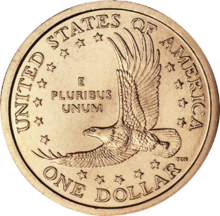United States | |
| Value | 1.00 United States dollar |
|---|---|
| Mass | 8.100 g (0.26 troy oz) |
| Diameter | 26.49 mm (1.043 in) |
| Thickness | 2.00 mm (0.079 in) |
| Edge | Plain (2000–2008) Lettered (2009–present) |
| Composition | Core: 100% Cu Cladding: 77% Cu, 12% Zn, 7% Mn, 4% Ni Overall: 88.5% Cu, 6% Zn, 3.5% Mn, 2% Ni[1] |
| Years of minting | 2000–2001; 2009-2011 (circulation) 2002–2008; 2012-present (collectors only) [2] |
| Mint marks | P (Philadelphia) D (Denver) S (San Francisco) W (West Point, special strikings only) |
| Obverse | |
| Design | Profile of Sacagawea with her child, Jean Baptiste Charbonneau |
| Designer | Glenna Goodacre |
| Design date | 2000 |
 | |
| Design | Date and mint mark removed |
| Designer | Glenna Goodacre |
| Design date | 2009 |
| Reverse | |
 | |
| Design | Soaring eagle |
| Designer | Thomas D. Rogers |
| Design date | 2000 |
| Design | Various; one design per year |
| Designer | Various |
| Design date | 2009–present |
The Sacagawea dollar (also known as the "golden dollar") is a United States dollar coin introduced in 2000, but subsequently minted only for niche circulation from 2002 onward. The coin generally failed to meet consumer and business demands. It is still generally accepted in circulation.
These coins have a copper core clad by manganese brass, giving them a distinctive golden color. The coin features an obverse by Glenna Goodacre. From 2000 to 2008, the reverse featured an eagle design by Thomas D. Rogers. Since 2009, the reverse of the Sacagawea dollar has been changed yearly, with each design in the series depicting a different aspect of Native American cultures. These coins are marketed as "Native American dollars".
The coin was introduced as a replacement for the Susan B. Anthony dollar, which proved useful for vending machine operators and mass transit systems despite being unpopular with the public. The Statue of Liberty was originally proposed as the design subject, but Sacagawea, the Shoshone guide of the Lewis and Clark Expedition, was eventually chosen.
The new dollar coin was heavily marketed by the Mint in a series of print, radio, and television advertisements, as well as Mint partnerships with Walmart and Cheerios. However, the Sacagawea dollar did not prove popular with the public, and mintage dropped sharply in the second year of production. Production of Sacagawea dollars continued, from 2007 to 2016, in parallel with the U.S. Presidential dollars. In 2012, mintage numbers were reduced by over 90%, in line with a similar reduction for the even less popular Presidential Dollars, because of large stockpiles of unused coins from that series.
The Mint planned to issue the Sacagawea design in 22-karat gold as well, but this idea was quickly abandoned after the Mint's authority to strike the coins was questioned, and the Mint has retained ownership of the few such coins produced. Soon after initial production of the dollar, it was noticed that a few of the dollar coins were erroneously struck with the obverse of a state quarter and the normal reverse. These coins, 2000 Sacagawea dollar – Washington quarter mules, are a rare example of a genuine accidental mule coin produced by the US Mint.
- ^ United States Mint. "Golden Dollar Coin Design". Archived from the original on March 4, 2016. Retrieved February 16, 2015.
- ^ "Circulating Coins - U.S. Mint". www.usmint.gov. Archived from the original on April 15, 2016. Retrieved April 7, 2016.